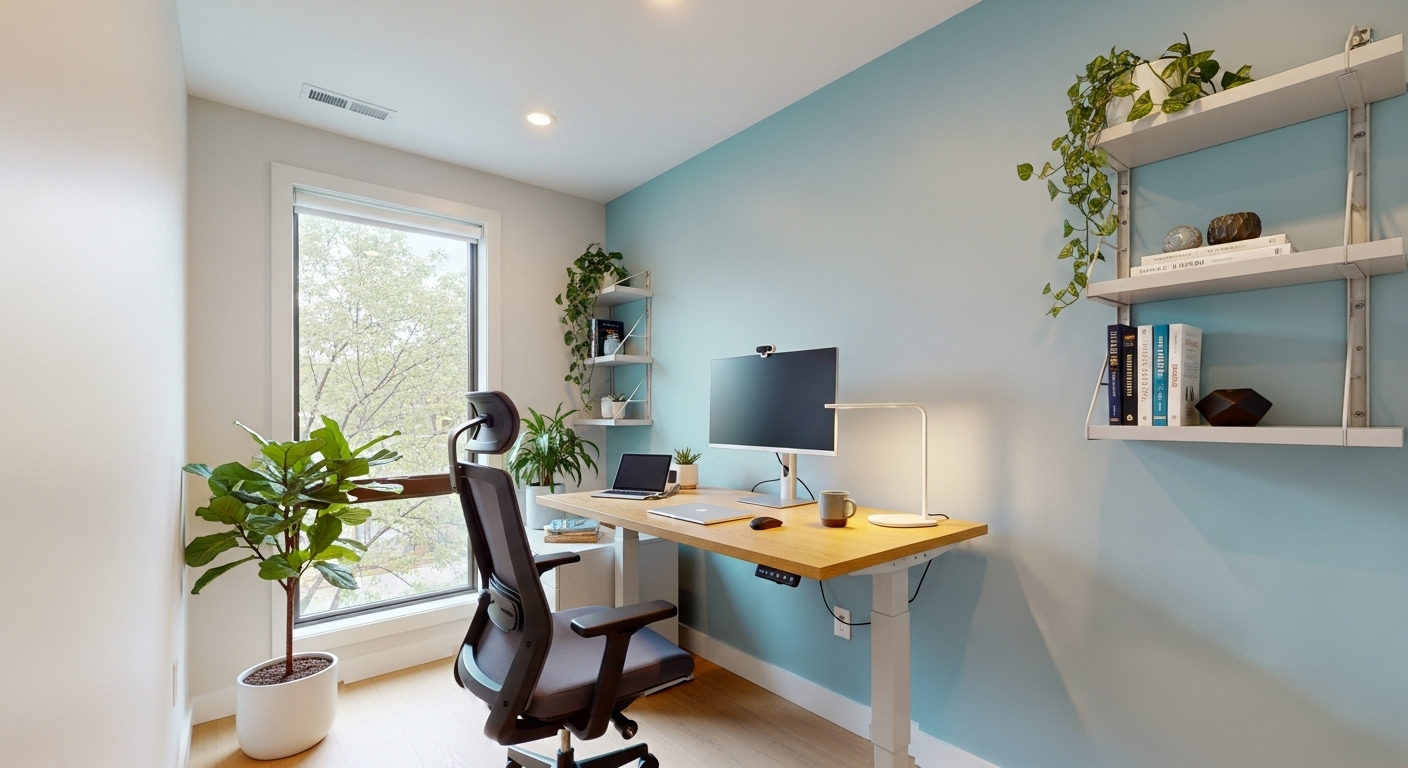The modern coworking space presents a compelling paradox. It’s a vibrant hub engineered for connection and synergy, yet that very energy can become the primary obstacle to the deep, focused work required for true productivity. Many professionals flock to these shared environments to escape the isolation of home, only to find themselves battling a different set of challenges: ambient noise, constant movement, and tempting social interruptions. The solution isn’t to retreat, but to reframe your approach. Instead of passively reacting to your environment, you must become a ‘Productivity Architect’—the master designer of your own workflow. This involves proactively structuring your day, curating your tools, and strategically engaging with your surroundings. This guide provides a comprehensive blueprint for transforming any coworking space from a potential minefield of distractions into your personal fortress of focus, enabling you to harness its energy without sacrificing your output.
Laying the Foundation: Choosing a Space That Amplifies, Not Disrupts
Before you can optimize your productivity within a coworking space, you must first select the right one. Not all shared offices are created equal, and the foundation of your success lies in choosing an environment that aligns with your specific work style and needs. Many people prioritize location or cost, but the most critical factor for productivity is the space’s functional design. Begin your search by evaluating the layout. Does it offer distinct zones? A space that thoughtfully separates quiet, heads-down areas from collaborative, high-energy zones provides the flexibility you need to match your environment to your task. Pay close attention to the acoustic design; features like high-quality soundproofing, acoustic panels, and even white noise systems can make a monumental difference. Visit potential spaces during peak hours to get a realistic sense of the ambient noise level. Another key consideration is the availability of essential amenities for focus. Look for an ample supply of private phone booths or small, bookable rooms. These are non-negotiable for taking calls, participating in video conferences, or simply guaranteeing an hour of uninterrupted deep work. Lastly, assess the community culture. Some spaces are highly social and event-driven, while others cultivate a more studious, library-like atmosphere. Neither is inherently better, but choosing one that clashes with your personality will create constant friction. Your goal is to find a space that doesn’t force you to adapt, but rather provides the raw materials you need to construct your ideal workday.
The Focus Fortress: Engineering an Environment for Deep Work
Once you’ve chosen the right space, the next step is to engineer your immediate environment for concentration. This is about building a ‘focus fortress’—a personal bubble that signals to both your brain and those around you that you are engaged in deep work. The cornerstone of this fortress is a high-quality pair of noise-canceling headphones. This is not a luxury but an essential tool for blocking out the unpredictable soundscape of a shared office. The simple act of putting them on creates a powerful psychological trigger, signaling the transition into a state of focus. Complement this with digital defenses. Use browser extensions or apps like Freedom or Cold Turkey to block distracting websites and notifications for set periods. This removes the temptation for mindless scrolling and keeps your attention locked on the task at hand. Next, establish ‘desk rituals.’ This could be as simple as clearing your desk, brewing a specific type of tea, or opening your task manager. These repeated actions create a Pavlovian response, conditioning your brain to enter work mode on command. Finally, master the art of non-verbal communication. In a busy environment, you need to signal your unavailability without being rude. A small, elegant desk sign that reads ‘In Deep Focus’ or simply turning your headphones so the brand logo is visible can be surprisingly effective. By combining these physical, digital, and behavioral strategies, you erect invisible walls that protect your most valuable asset: your attention.
Strategic Socialization: Leveraging the Community Without Derailing Your Day
One of the primary draws of a coworking space is its built-in community—a diverse network of professionals offering opportunities for collaboration, learning, and serendipitous connections. However, this same community can be the single greatest threat to your productivity if left unmanaged. The key is to shift from reactive, random interactions to strategic, intentional engagement. Instead of letting ‘quick questions’ and casual chats fragment your focus time, schedule your socialization. Treat coffee breaks, lunch, and post-work events as dedicated networking blocks in your calendar. When you do take a break, be fully present. Leave your desk and engage with others in the common areas. This compartmentalization allows you to reap the benefits of the community without letting it bleed into your deep work sessions. Furthermore, be purposeful in your networking. Identify individuals or companies within the space that align with your professional goals and make a point to connect with them during these scheduled times. This transforms casual chatter into valuable relationship-building. It’s also critical to set clear boundaries. If someone approaches you while you’re in ‘focus mode,’ it’s perfectly acceptable to politely say,
‘I’m in the middle of something right now, but I’d love to chat. Can I find you in the kitchen in about an hour?’
This respects both your work and their desire to connect. By treating socialization as a scheduled, strategic activity, you transform it from a productivity drain into a powerful professional asset.
The Digital & Physical Toolkit: Optimizing Your Gear for Mobility and Focus
In a flexible environment like a coworking space, your productivity is directly tied to the efficiency of your tools. A well-curated digital and physical toolkit ensures you can work effectively from any desk, in any zone, at any time. Your physical setup should be built for both ergonomics and portability. A lightweight laptop stand, a slim external keyboard, and a portable mouse are essential investments. These items prevent the physical strain of hunching over a laptop and allow you to create a comfortable, consistent workstation wherever you sit. This small ‘go-bag’ of essentials minimizes setup time and friction, allowing you to get to work faster. On the digital front, cloud storage is non-negotiable. Using platforms like Google Drive, Dropbox, or OneDrive ensures all your files are accessible and synced, whether you’re working from a hot desk, a phone booth, or a meeting room. Equally important is your task and project management system. Tools like Asana, Trello, or Monday.com help you capture, organize, and prioritize your work, providing a clear roadmap for your day that is independent of your physical location. This digital command center is crucial for maintaining momentum. Effective communication tools are also part of the stack, but they must be managed. Tame your Slack or Teams notifications by setting a status, muting non-essential channels, and checking messages in batches rather than responding to every ping in real time. Your toolkit should serve your focus, not shatter it. By optimizing your gear, you create a seamless, portable, and distraction-resistant operating system for success.
Ritual and Rhythm: Building a Sustainable and Productive Coworking Routine
Thriving in a coworking space isn’t about isolated productivity sprints; it’s about building a sustainable rhythm that supports consistent high performance. This is where rituals and routines come into play, providing the structure that human brains crave, especially in a fluid environment. Start by creating a ‘commute’ ritual. Even if your actual commute is short, a 10-15 minute routine before you start work—like listening to a specific podcast or walking around the block—helps transition your brain from home mode to work mode. An ‘end-of-day’ ritual is just as important. Spend the last 15 minutes reviewing what you accomplished, planning your top priorities for the next day, and tidying your workspace. This creates a clean break, preventing work from bleeding into your personal time. During the workday, implement a time management technique that works for you. The Pomodoro Technique, with its 25-minute focus intervals and 5-minute breaks, is exceptionally well-suited to the coworking environment, as it provides frequent opportunities to reset your attention. Alternatively, task batching—grouping similar activities like answering emails, making calls, or doing creative work—can significantly improve efficiency by minimizing context switching. Crucially, you must schedule breaks and honor them. Step away from your desk, leave the building, or simply sit in a common area without your devices. These moments of rest are not lazy; they are essential for cognitive function and preventing burnout. By establishing these daily and weekly rhythms, you create a predictable and powerful structure that drives productivity and well-being over the long term.
Mindset and Boundaries: The Psychological Architecture of Productivity
Ultimately, the most sophisticated tools and routines will fail without the right psychological foundation. The final, and perhaps most crucial, layer of your productivity architecture is your mindset and your ability to set firm boundaries. First, you must redefine what a ‘productive day’ looks like. In a traditional office, productivity is often conflated with presence—being at your desk for eight straight hours. A coworking environment liberates you from this outdated notion. True productivity is about output, not hours logged. Embrace the flexibility. If you accomplish your key tasks in a focused six-hour block, give yourself permission to leave early. This outcome-oriented mindset is essential for leveraging the freedom of coworking. Second, you must set clear boundaries with yourself. It’s easy to feel ‘productivity guilt’ when you see others working intensely around you. Resist the urge to compare. Your work, your goals, and your energy levels are unique. Trust your system and your plan for the day. This also involves setting boundaries with your work itself. The ‘always on’ culture can be even more pervasive when your workspace is a hub of activity. Use your end-of-day ritual to mentally clock out, and avoid checking work email or messages once you’ve left the space. This psychological separation is vital for long-term sustainability and avoiding burnout. By cultivating a mindset of focused, outcome-driven work and protecting your mental energy with strong boundaries, you build the resilient inner architecture needed to thrive amidst the buzz of a shared workspace.
Becoming a Productivity Architect is an empowering shift from being a passive occupant to an active creator of your work experience. It’s about recognizing that you hold the power to shape your environment, manage distractions, and design a workflow that unlocks your peak potential. The journey begins with the strategic selection of a space that provides the right foundation. From there, you construct your focus fortress with a combination of physical tools and digital defenses. You learn to engage with the vibrant community on your own terms, transforming potential distractions into strategic assets. This is all supported by a well-organized toolkit and a sustainable daily rhythm that fosters consistency over intensity. Finally, it’s anchored by a powerful mindset that values results over hours and protects your mental energy with firm boundaries. By embracing this holistic approach, you can move beyond simply surviving in a coworking space and truly start to thrive, harnessing its dynamic energy to fuel your most focused, creative, and productive work.





